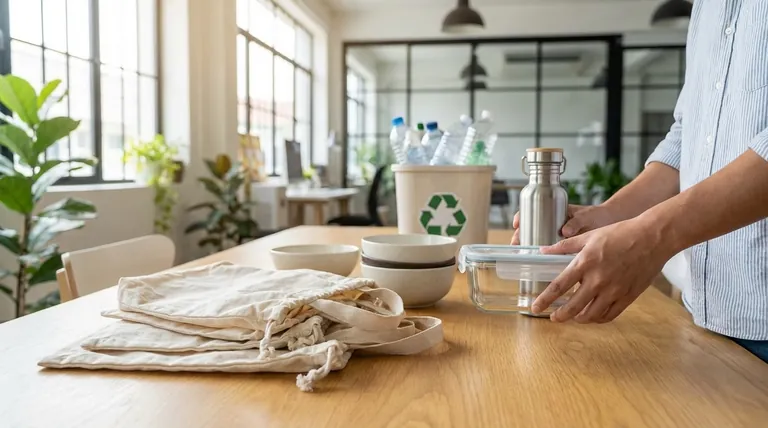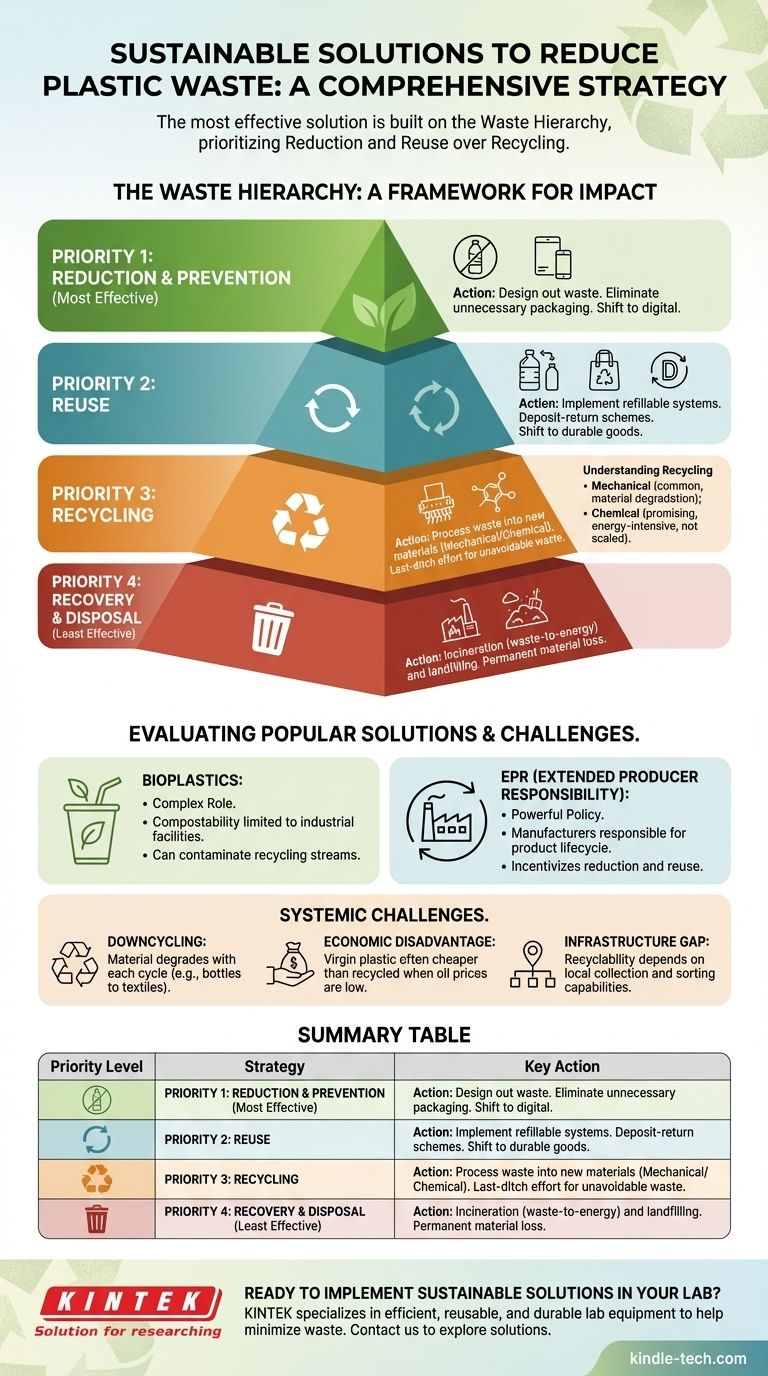虽然没有单一技术能提供万能药,但减少塑料垃圾最有效和可持续的解决方案是基于废弃物管理层级的综合策略。该框架根据环境影响的顺序优先采取行动,在考虑回收利用之前,将重点放在减量和再利用上。这种方法从源头解决问题,而不仅仅是管理症状。
关键的错误是将回收利用作为主要解决方案。真正的可持续性是通过从根本上重新思考设计、消费和政策来实现的,从而从一开始就消除对一次性塑料的需求。
基础:理解废弃物管理层级
废弃物管理层级是一个普遍接受的框架,指导可持续的废弃物管理。它将废弃物管理选项从最优先到最不优先进行排序,迫使人们将重点从下游问题(如回收)转向上游解决方案(如预防)。
优先事项1:减量和预防
这是最具影响力的单一措施。最可持续的塑料是那些从未被制造出来的塑料。
减量包括设计需要更少材料或根本不需要塑料的系统和产品。这包括消除不必要的包装,“轻量化”必需产品,以及转向数字替代品。
优先事项2:再利用
如果塑料无法消除,次优选择是尽可能长时间地以其原始形式保持使用。
再利用系统,例如用于饮料和清洁产品的可再填充容器或押金返还计划,可以保留材料的价值,并显著减少制造新物品所需的能源和资源。它代表着从一次性使用到耐用思维的转变。
优先事项3:回收利用
回收利用是将废弃塑料进行回收并再加工成新产品的过程。它是解决方案中至关重要的一部分,但它之所以是第三优选择是有原因的。
虽然它将材料从垃圾填埋场转移,但该过程存在显著局限性,包括能源消耗、材料降解和污染问题。对于无法消除或再利用的物品,它应被视为最后的努力。
最后手段:回收和处置
这一层级包括垃圾焚烧发电等过程,以及最不理想的垃圾填埋。这些选项适用于无法预防、再利用或回收的垃圾,并导致材料资源的永久损失。

通过此视角评估流行的“解决方案”
许多提出的解决方案获得了媒体关注,但其真正的可持续性可以通过废弃物管理层级进行评估。
生物塑料的作用
生物塑料常被视为简单的解决方案,但其作用复杂。有些生物塑料被设计成可堆肥的,但仅限于工业设施,而非后院垃圾桶或开放环境。
此外,它们的生产可能涉及与土地和水资源使用相关的环境足迹。如果它们进入传统的塑料回收流,它们会成为污染物,可能破坏整批可回收材料。
生产者延伸责任(EPR)的力量
生产者延伸责任(EPR)是一种政策方法,使制造商对其产品的整个生命周期负责,包括其收集和最终处置。
这是减量和再利用的强大杠杆。当公司承担其包装废弃物的财务成本时,他们会直接受到激励,设计出更轻、更易于再利用和更有效回收的产品。
化学回收与机械回收
机械回收是最常见的类型,涉及将塑料粉碎、清洗、熔化和重塑。化学回收(或“高级回收”)则使用各种工艺将塑料分解成其原始分子结构单元,然后可用于制造新的、原始质量的塑料。
虽然化学回收有望处理难以回收的混合塑料,但它目前能耗很高,通常产量较低,并且尚未在大规模、经济可行的范围内得到验证。
理解权衡和系统性挑战
实现塑料的循环经济需要承认当前系统内存在的重大障碍。
无限回收的神话
大多数常见塑料无法无限回收。塑料熔化和重塑的过程会降解聚合物链,这种现象被称为降级回收。
经过几个循环后,材料会失去其结构完整性,必须用于质量较低的产品(例如,塑料瓶变成纺织品或木材),直到最终被填埋或焚烧。
经济劣势
回收塑料必须与原生塑料竞争,原生塑料直接由化石燃料生产。当油价低时,原生塑料通常比回收塑料更便宜、质量更高,这为制造商使用回收材料创造了不良的经济激励。
基础设施差距
如果缺乏当地的收集、分类和处理基础设施,产品的可回收性就毫无意义。回收设施的可用性和能力在不同城市和国家之间差异巨大,导致消费者普遍困惑和实际回收率低下。
为您的目标做出正确选择
为了有效促进解决方案,您的行动必须与废弃物管理层级保持一致。
- 如果您是产品设计师或企业领导者:您的主要重点应放在从一开始就设计消除浪费,通过探索无塑料材料并投资于强大的再利用和再填充系统。
- 如果您是政策制定者:优先制定像生产者延伸责任(EPR)这样的立法,并为再利用基础设施提供资金,这为减少浪费创造了上游激励。
- 如果您是个人消费者:您最大的力量在于减少一次性物品的消费,并积极选择可重复使用的替代品,将回收利用作为您的最后选择,而不是首选。
塑料的可持续未来不是通过更好地管理废物来实现的,而是通过建立一个从一开始就不产生废物的经济和社会系统来实现的。
总结表:
| 优先级别 | 策略 | 关键行动 |
|---|---|---|
| 1(最有效) | 减量与预防 | 设计消除浪费,消除不必要的包装 |
| 2 | 再利用 | 实施可再填充系统,押金返还计划 |
| 3 | 回收利用 | 将废弃物加工成新材料(机械/化学) |
| 4(最不有效) | 回收与处置 | 焚烧,垃圾填埋作为最后手段 |
准备好在您的实验室实施可持续解决方案了吗? KINTEK 专注于实验室设备和耗材,通过高效、可重复使用和耐用的产品帮助实验室最大限度地减少浪费。让我们支持您的可持续发展目标——立即联系我们的专家,了解我们的解决方案如何帮助您在保持高性能的同时减少对环境的影响。
图解指南








